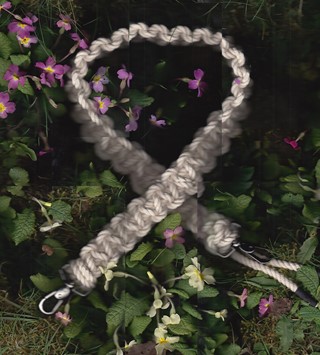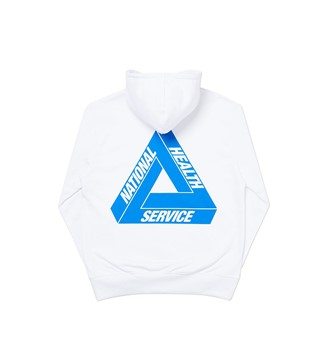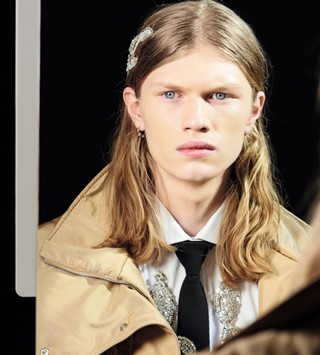In a new series, Calum Gordon charts the history of hip hop’s style through four different brands
- TextCalum Gordon
Whether it’s Gucci and Louis Vuitton riffing on the work of Dapper Dan, or the contemporary streetwear labels building on the foundations of early pioneers like Stüssy and X-LARGE, hip hop’s influence on how we dress in undeniable, and fittingly, impactful. Each epoch of this subculture turned de facto pop culture has come with its own host of styles and labels. To chart each one – often specific to regions or neighbourhoods, or trends with limited lifespans – would be impossible. But some brands have left a lasting impact, either stylistically or on how we have come to view hip hop as a driving force within contemporary fashion. In The History of Hip Hop Style in Four Brands, which coincides with the A/W18 men’s shows, we look at those brands whose wares or influence continue to resonate.
Hip hop has a vast, complex and nuanced sartorial past, but one of its most common and recurring motifs is tension. Much of its aesthetic has been defined by this tension, a subtle push and pull between fierce individuality and not pushing things too far and leaving artists vulnerable to derision. There are, of course, outliers – from Slick Rick to Andre 3000 to Young Thug, these are exceptions that prove the rule, who have created their own spaces in which to exist. But most rappers are not Young Thug, and could only dream of being 3 Stacks, leaving others to tread the tightrope between flamboyance and a sense of street-level authenticity.
Workwear has almost always provided the latter. It has a purpose and a grit about it, projecting these values through tough fabrics and utilitarian pockets. Rap has always maintained a glut of figures who value such qualities, specialising in a particular brand of steeliness. You could point to any number of workwear brands as an exemplar of this one facet of hip hop style: Timberland’s wheat-coloured boots have been an enduring New York staple – dating back to the days of Notorious BIG and a young Jay Z, who would who would buy a fresh pair every Saturday and sign his old ones for the sales assistant to keep – while on the West Coast, Dickies have long been the go-to choice of workwear for rappers, an extension of the style favoured by the gangs of Compton and LA. But few labels have had such widespread appeal as Carhartt, commanding attention and adoration on both coasts, from the likes of Nas and Naughty By Nature, as well as Tupac and Eazy-E.
With its oversized cuts and rugged fabrics, Carhartt’s clothing has always chimed with the hyper-masculine ideals and aesthetics that have underpinned much of mainstream hip-hop. Their jackets were bulky and imposing, adding mass and presence to any frame. But like many of the stylistic developments in hip hop – such as its love-affair with luxury labels – it was the hustlers on the streets who can lay claim to pioneering the label in this new context. The very same properties which had always seen the brand favoured by labourers in factories and on farms, also lent themselves well to those engaging in more illicit forms of work in more populated areas, where nights spent on street corners saw warmth, durability and adequate storage as beneficial properties in a jacket. (The ample pockets also aided graffiti writers, an oft-forgotten pillar of hip hop’s early days.)

The adoption of the label has always come with subtle differences depending on where you’re from. “New York, hip-hoppers prefer their Carhartts mustard brown and hunter green with baggy corduroy pants stuffed into Timberland boots,” noted a 1992 New York Times article, which quotes Albee Ragusa, then director of Rap Marketing for Tommy Boy Records. “In Los Angeles, Mr Ragusa said, the look is more “chain gang”: Carhartts in darker colours with shirts worn underneath and buttoned to the neck. And arguably, hip hop’s love affair with Carhartt was cemented by Ragusa’s employer, the legendary East Coast imprint Tommy Boy. In 1989, the label bought up stock of classic Carhartt jackets, and embroidered their own motif on them, along with that of then-nascent streetwear label Stüssy, selling it on as their own merchandise – and in turn creating a streetwear collaboration, before such a notion ever existed. Throughout the 90s, the label with the instantly recognisable golden ‘C’ remained omnipresent. In Mobb Deep’s video for Survival of the Fittest video, we had perhaps the most apt setting and title for why it endured.
One of the unforgettable scenes of Mathieu Kassovitz’s cult classic La Haine, sees Cut Killer, a French-Moroccan DJ, swing open the windows of his apartment, and begin to fill the concrete jungle below with the sound of French rap group Supreme NTM’s Police clashed with the iconic Non, Je Ne Regrette Rien. French hip hop was seminal in the film’s aesthetic, according to the director, and throughout it the central figure of Hubert proudly sports a Carhartt beanie. This was, Kassovitz says, a reflection of French hip hop’s love of the label at the time, which regularly borrowed stylistic and sonic cues from their stateside counterparts. “Hubert is more of a hip hop guy,” he explained in a 2010 interview. “Hubert is more the kind of guy who minds his own business, who is honest and doesn’t need much money. He’s an urban survivalist. That’s why he wears Carhartt.”

Today, the brand’s influence can still be seen. While Kanye West has cycled through everything from leather kilts to jewel-encrusted Margiela face-masks, Carhartt has remained a near-constant staple in his wardrobe, anchoring his penchant for the avant-garde with his post-dad reality. It’s also hard to not see the washed-out workwear, which so frequently appears in West’s Yeezy collections, as having some sort of lineage from Carhartt – the muted hues and boxy cuts all feel like elevated riffs on the label’s unassuming, affordable offerings.
Meanwhile, Action Bronson – the rapper turned TV food show host – has adopted the brand’s long sleeve henley t-shirts as somewhat of a uniform. Livewire Detroit artist Danny Brown, as well as A$AP Ferg and A$AP Rocky are fans. In Rocky – who introduced niche labels such as Raf Simons and Rick Owens into the average rappers’ lexicon in 2011 – exists perhaps the perfect paradigm of the tension which has underpinned the wardrobe choices of many of his peers. In Carhartt he finds a symbol of humble authenticity, something to offset other more esoteric choices – typifying the brand’s enduring allure for rappers past and present.
Calum Gordon is a Berlin-based fashion writer and the co-author of Contemporary Menswear. His work has also appeared in Dazed, SSENSE, and Kaleidoscope.
















